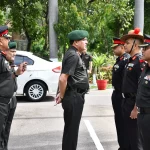Choosing a career path is a pivotal moment in every student’s life, particularly in India, where the educational landscape can be daunting due to the wide array of possibilities. Among the most notable options are the National Defence Academy (NDA) and the Joint Entrance Examination (JEE), which cater to dramatically different futures. While NDA opens the door to a life in the Indian Armed Forces, JEE leads to opportunities in engineering and technology through premier institutes like the Indian Institutes of Technology (IITs). Understanding the distinct challenges, educational frameworks, and career outcomes associated with each route is fundamental to making an informed choice that aligns with one’s aspirations and capabilities.
Historical Context
The NDA was established in 1954, becoming the first tri-services academy in the world, which shapes the future leaders of the Indian Armed Forces through rigorous training and discipline. NDA has a storied tradition, representing honor, valor, and service to the nation. Future officers not only receive academic education but engage deeply in character-building and physical fitness routines.
On the other hand, the JEE, initiated in 1960, has evolved into one of the most competitive examinations in India, assessing candidates’ proficiency in Physics, Chemistry, and Mathematics for securing places in India’s prestigious engineering colleges. Over the years, the JEE has adapted to changing educational needs and continually strives to identify students who have the capability to excel in technical domains.
Understanding the Purpose and Career Path
National Defence Academy (NDA)
The NDA is tailored for individuals seeking a career in the Indian Armed Forces, including the Army, Navy, and Air Force. Enrollees undergo extensive training to cultivate leadership qualities, discipline, and confidence, which are essential traits for future officers. The nature of the service career necessitates not only academic knowledge but also a considerable emphasis on physical and mental endurance. Upon completion of training, graduates are commissioned as officers in their respective services.
Joint Entrance Examination (JEE)
In contrast, the JEE lays the groundwork for a career in engineering and technology. It serves as a gateway to various prestigious engineering institutes across India, most notably the IITs. A successful JEE candidate typically embarks on a journey toward becoming an engineer, a domain that encompasses design, development, and innovation across multiple sectors. Graduates are often poised for careers in technology, research, entrepreneurship, and higher studies.
Exam Structure and Syllabus
NDA Exam Structure
The NDA examination is composed of three main components:
- Mathematics – Covers topics such as Algebra, Trigonometry, and Analytical Geometry at a school level.
- General Ability Test – This includes:
- English: Comprehension and usage of the language.
- General Knowledge: An array of subjects including history, geography, current affairs, etc.
- Basic Science: Focuses on elementary scientific principles.
- Indian Polity: Introduces candidates to the political framework of the country.
Finally, candidates must also complete the Services Selection Board (SSB) interview, which assesses their mental and physical stature, potential for leadership, and adaptability.
JEE Exam Structure
The JEE is divided into two stages:
- JEE Main: This stage assesses knowledge in Physics, Chemistry, and Mathematics primarily at the Class 12 level. It serves to filter candidates for the next stage.
- JEE Advanced: The difficulty here escalates, as it tests candidates on their conceptual understanding and problem-solving skills across the three disciplines.
Both exams stress deep comprehension and logical application of concepts. With JEE, candidates encounter complexities that require not only knowledge but also advanced analytical skills to solve challenging problems.
Competition and Selection Ratio
NDA
The NDA examination is known for its stringent selection process:
- Total Seats: Approximately 350 per year.
- Selection Ratio: Roughly 0.15%, signifying an extremely competitive environment.
These low acceptance rates underline the high standards set by the NDA, where candidates are evaluated rigorously, not just based on their academic prowess but also on their physical and psychological suitability for a military career.
JEE
Conversely, JEE garners attention from about 1.5 million candidates annually:
- Total Seats at IITs: Nearly 9,000, with many additional seats available in other engineering institutes like NITs and IIITs.
- Selection Ratio: Approximately 0.71% at IITs, indicating a significant but more accessible competition compared to NDA.
Both NDA and JEE demand extensive preparation and commitment, but they highlight different paths with their own unique challenges and rewards.
Difficulty Comparison
Both examinations are considered among the most challenging in India, albeit focusing on varied skill sets:
- NDA: The exam’s difficulty is perceived as moderate to high. Success not only requires academic understanding but physical fitness and the right psyche—a candidate must also excel in the SSB interview, which adds a layer of complexity.
- JEE: The difficulty level is exceptionally high, as it probes deep academic knowledge and the capacity for problem-solving, especially in JEE Advanced, where only the cream of the crop can thrive.
Eligibility and Gender
It’s essential to note the eligibility criteria that differentiate both paths:
- NDA: Traditionally, it has been male-dominated, eligible only for male candidates. This norm is slowly changing, with gradual inclusion of female candidates. Candidates must also meet strict age and physical standards, involving a comprehensive health check.
- JEE: It welcomes candidates of all genders, providing a more inclusive atmosphere for aspiring engineers to pursue higher education without any such restrictions.
Preparation Overlap and Hybrid Programs
In response to the unique demands of both examinations, several coaching institutions have developed hybrid training programs to cater to aspirants preparing for both NDA and JEE.
For example, SSBCrack and SSBCrackExams provide comprehensive preparation resources, including study materials and online courses aimed at helping students stay competitive in both arenas. This approach not only maximizes candidates’ opportunities but also allows for a more versatile skill set, bridging leadership qualities and technical expertise.
Case Studies and Real-world Applications
Many successful individuals have taken divergent paths through NDA or JEE to noteworthy careers.
NDA Success Story:
Consider the example of General Bipin Rawat, a distinguished alumnus of the NDA, who has risen to eminent ranks within the Indian Army. His achievements underscore the tremendous career potential one can attain through the disciplined and rigorous training at the NDA.
JEE Success Story:
Conversely, Sundar Pichai, CEO of Alphabet Inc., reflects the opportunities that arise from excelling in engineering education, rooted in a robust foundation in Physics, Chemistry, and Mathematics through JEE. His journey emphasizes how engineering professions can lead to influential roles in global enterprises.
These case studies illuminate the rich tapestry of possibilities stemming from each path, illuminating potential high-impact careers that evolve from a commitment to these rigorous examinations.
Statistical Data and Research Insights
Grasping the full breadth of implications offered by both examinations involves understanding associated statistics:
- Career Growth: 70% of NDA graduates have successful careers within the Armed Forces, displaying a lower dropout compared to civilian counterparts.
- Post-JEE Opportunities: Engineering graduates from IITs often command starting salary packages that can reach over ₹15 lakh per annum, reflecting the high demand and prestige associated with engineering careers in India.
Challenges and Solutions
Both paths present distinct challenges:
NDA Challenges
- Physical Demands: Many aspirants struggle with the rigorous fitness requirements.
- Solution: Early physical training can prepare students better for the physical assessment phases of the NDA.
- Competitive Pressure: Low acceptance rates can lead to anxiety and discouragement.
- Solution: Regular mock assessments and psychological counseling can aid in better preparation and emotional health management.
JEE Challenges
- Academic Pressure: Many students find the syllabus daunting.
- Solution: Comprehensive study plans and joining peer study groups can provide support and enhance understanding.
- Lack of Personalized Guidance: Students often face issues identifying weak areas.
- Solution: Engaging with expert tutors (like SSBCrack) can provide tailored guidance to focus on areas needing improvement.
Future Trends and Predictions
As India transitions further into a technologically-led economy, the prominence of engineers and defence personnel will continue to be vital. The alignment of curricula with global technical standards in both the NDA and JEE fosters a cohort of professionals who can thrive in unpredictable environments.
With the increasing convergence of engineering and defence technology, preparing for both NDA and JEE may become a more common practice. There are trends leaning toward incorporating scientific education within military training, highlighting a unique intersection of roles, fostering innovation within defence services.
In conclusion, the decision between pursuing NDA and JEE largely hinges on individual interests, strengths, and long-term career goals. Whether choosing the path of a military officer or an engineer, each has its unique set of rewards and challenges. Through understanding these pathways deeply—backed by historical context, structured syllabi, competition analytics, and real-world implications—students can make an informed decision that resonates with their aspirations and professional visions.
The journey to either Academy is bound to shape significant future leaders, engineers, and innovators who will contribute significantly to both national service and technological advancement within India. Consider your skills and passions carefully, and remember that each pathway offers a fulfilling journey laden with opportunities.













